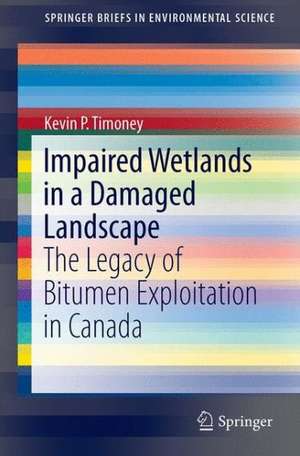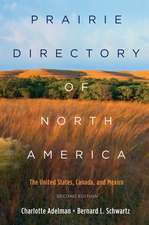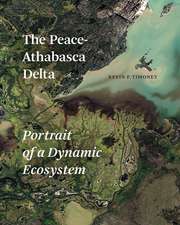Impaired Wetlands in a Damaged Landscape: The Legacy of Bitumen Exploitation in Canada: SpringerBriefs in Environmental Science
Autor Kevin P. Timoneyen Limba Engleză Paperback – 14 iul 2015
Din seria SpringerBriefs in Environmental Science
-
 Preț: 348.77 lei
Preț: 348.77 lei -
 Preț: 382.57 lei
Preț: 382.57 lei -
 Preț: 378.12 lei
Preț: 378.12 lei -
 Preț: 378.80 lei
Preț: 378.80 lei -
 Preț: 381.98 lei
Preț: 381.98 lei -
 Preț: 347.80 lei
Preț: 347.80 lei - 15%
 Preț: 464.18 lei
Preț: 464.18 lei -
 Preț: 378.12 lei
Preț: 378.12 lei -
 Preț: 377.53 lei
Preț: 377.53 lei -
 Preț: 379.09 lei
Preț: 379.09 lei -
 Preț: 381.00 lei
Preț: 381.00 lei -
 Preț: 383.93 lei
Preț: 383.93 lei -
 Preț: 175.58 lei
Preț: 175.58 lei -
 Preț: 475.83 lei
Preț: 475.83 lei -
 Preț: 380.07 lei
Preț: 380.07 lei -
 Preț: 378.92 lei
Preț: 378.92 lei -
 Preț: 411.93 lei
Preț: 411.93 lei -
 Preț: 375.62 lei
Preț: 375.62 lei -
 Preț: 375.45 lei
Preț: 375.45 lei -
 Preț: 378.92 lei
Preț: 378.92 lei -
 Preț: 377.57 lei
Preț: 377.57 lei -
 Preț: 377.35 lei
Preț: 377.35 lei -
 Preț: 378.34 lei
Preț: 378.34 lei -
 Preț: 344.67 lei
Preț: 344.67 lei -
 Preț: 374.30 lei
Preț: 374.30 lei -
 Preț: 446.26 lei
Preț: 446.26 lei - 5%
 Preț: 361.96 lei
Preț: 361.96 lei -
 Preț: 376.43 lei
Preț: 376.43 lei -
 Preț: 380.63 lei
Preț: 380.63 lei -
 Preț: 375.84 lei
Preț: 375.84 lei - 15%
 Preț: 463.20 lei
Preț: 463.20 lei -
 Preț: 383.33 lei
Preț: 383.33 lei -
 Preț: 375.23 lei
Preț: 375.23 lei -
 Preț: 377.57 lei
Preț: 377.57 lei -
 Preț: 381.59 lei
Preț: 381.59 lei -
 Preț: 379.48 lei
Preț: 379.48 lei -
 Preț: 376.04 lei
Preț: 376.04 lei -
 Preț: 413.84 lei
Preț: 413.84 lei -
 Preț: 381.81 lei
Preț: 381.81 lei -
 Preț: 352.28 lei
Preț: 352.28 lei -
 Preț: 381.81 lei
Preț: 381.81 lei -
 Preț: 381.98 lei
Preț: 381.98 lei - 5%
 Preț: 331.65 lei
Preț: 331.65 lei -
 Preț: 375.62 lei
Preț: 375.62 lei -
 Preț: 377.95 lei
Preț: 377.95 lei -
 Preț: 413.45 lei
Preț: 413.45 lei -
 Preț: 267.19 lei
Preț: 267.19 lei -
 Preț: 373.73 lei
Preț: 373.73 lei -
 Preț: 375.62 lei
Preț: 375.62 lei
Preț: 362.43 lei
Nou
Puncte Express: 544
Preț estimativ în valută:
69.36€ • 75.31$ • 58.26£
69.36€ • 75.31$ • 58.26£
Carte tipărită la comandă
Livrare economică 18-24 aprilie
Preluare comenzi: 021 569.72.76
Specificații
ISBN-13: 9783319102344
ISBN-10: 3319102346
Pagini: 225
Ilustrații: XI, 218 p. 70 illus., 54 illus. in color.
Dimensiuni: 155 x 235 x 17 mm
Greutate: 0.33 kg
Ediția:2015
Editura: Springer International Publishing
Colecția Springer
Seria SpringerBriefs in Environmental Science
Locul publicării:Cham, Switzerland
ISBN-10: 3319102346
Pagini: 225
Ilustrații: XI, 218 p. 70 illus., 54 illus. in color.
Dimensiuni: 155 x 235 x 17 mm
Greutate: 0.33 kg
Ediția:2015
Editura: Springer International Publishing
Colecția Springer
Seria SpringerBriefs in Environmental Science
Locul publicării:Cham, Switzerland
Public țintă
ResearchCuprins
1. Introduction.- 2. Reclamation Policy and Scientific Context.- 3. Methods.- 4. The Vegetation.- 5. Chemical and Physical Properties of the Wetlands.- 6. Plant Species Richness and Diversity.- 7. Are Industrial Wetlands Changing Over Time.- 8. Differentiating Industrial from Natural Wetlands via Structural and Geographic Attributes.- 9. The Role of Regulations and Policy in Wetland Loss and Attempts at Reclamation.- 10. Impaired Wetlands: Further Considerations.- 11. The Future: Is Regional Environmental Degradation Inevitable?.- 12. Summary and Conclusions.
Notă biografică
Kevin Timoney is a well-rounded ecologist with extensive field, research, and writing experience and a commitment to solving complex environmental and ecological problems. He has expertise in subarctic and boreal ecology, vegetation, landscape, botany, climate change, hydrology, wildlife, disturbance ecology, the effects of environmental contaminants on humans and ecosystems, and statistics. He has a background in remote sensing, geography, pollution ecology, GIS, ecosystem management, zoology, restoration, geology, landforms, soils, and permafrost. He has done numerous interviews for television, radio, and documentary films on the effects of industrial development in the Athabasca bitumen sands region. As the principal investigator at Treeline Ecological Research, he conducts ecological research on a wide range of topics. Recent examples include vegetation and landscape ecology, rare flora, human effects on natural systems, high conservation value forest assessments, climate change, habitat studies, long-term ecological research and monitoring, forest and wetland ecology, and ecosystem and vegetation management. His most recent publication is a book on the Peace-Athabasca Delta, published in October 2013 by the University of Alberta Press. The book synthesizes the ecological, climatic, hydrologic, and human history of the delta over the past ten thousand years. He has conducted research for federal and provincial governments, industry, non-governmental organizations, and First Nations. Clients have included BC Hydro, Alberta-Pacific Forest Industries, the Alberta and federal governments, the Nunee Health Board Society (Fort Chipewyan), Keepers of the Athabasca, Athabasca Chipewyan First Nation, the Athabasca Tribal Council, Environmental Defence Canada, the Pembina Institute, Little Red River Cree First Nation, World Wildlife Fund, and many other organizations He is also an avid canoeist, woodsman, naturalist, gardener, and backcountry traveler.
Caracteristici
Examines long-term ecological recovery of wetlands impacted by open pit bitumen mining and tailings production in northeastern Alberta Describes the effects of bitumen exploitation on the floristic (species) composition and diversity of vascular plant communities, by examining differences between native and disturbed wetland habitats Of interest to scientists, engineers, ecologists and environmentalists working on the successful reclamation of wetland function Includes supplementary material: sn.pub/extras












